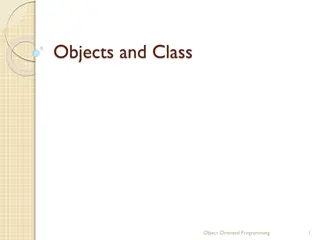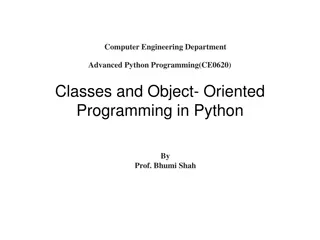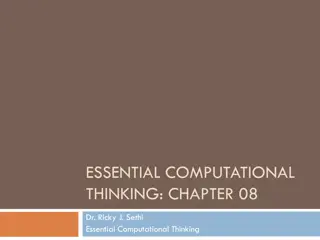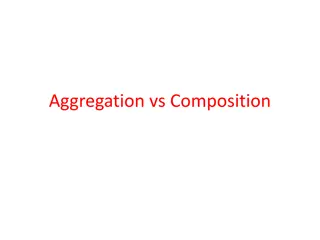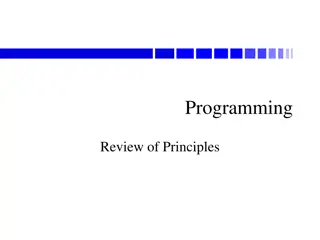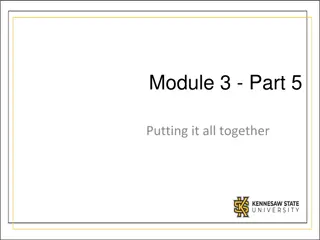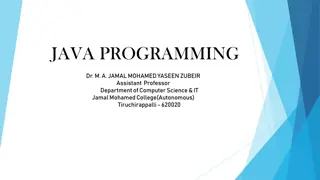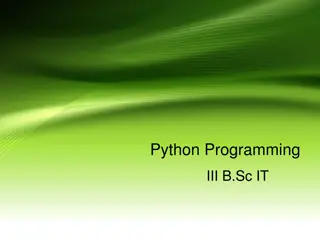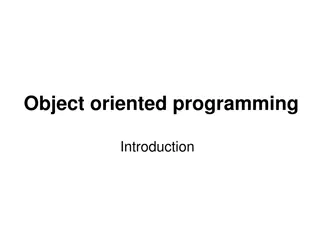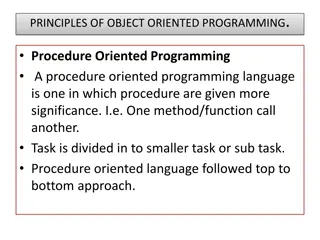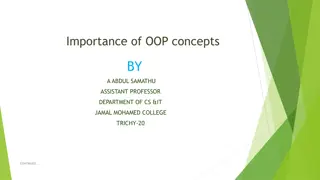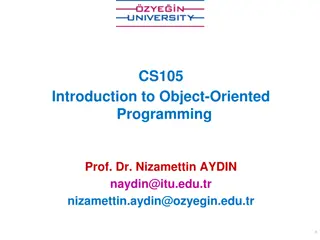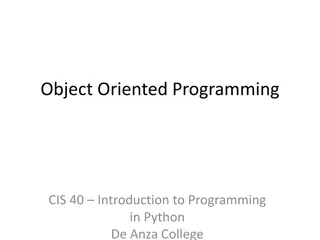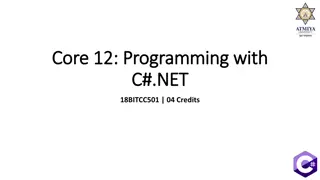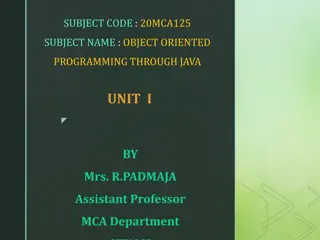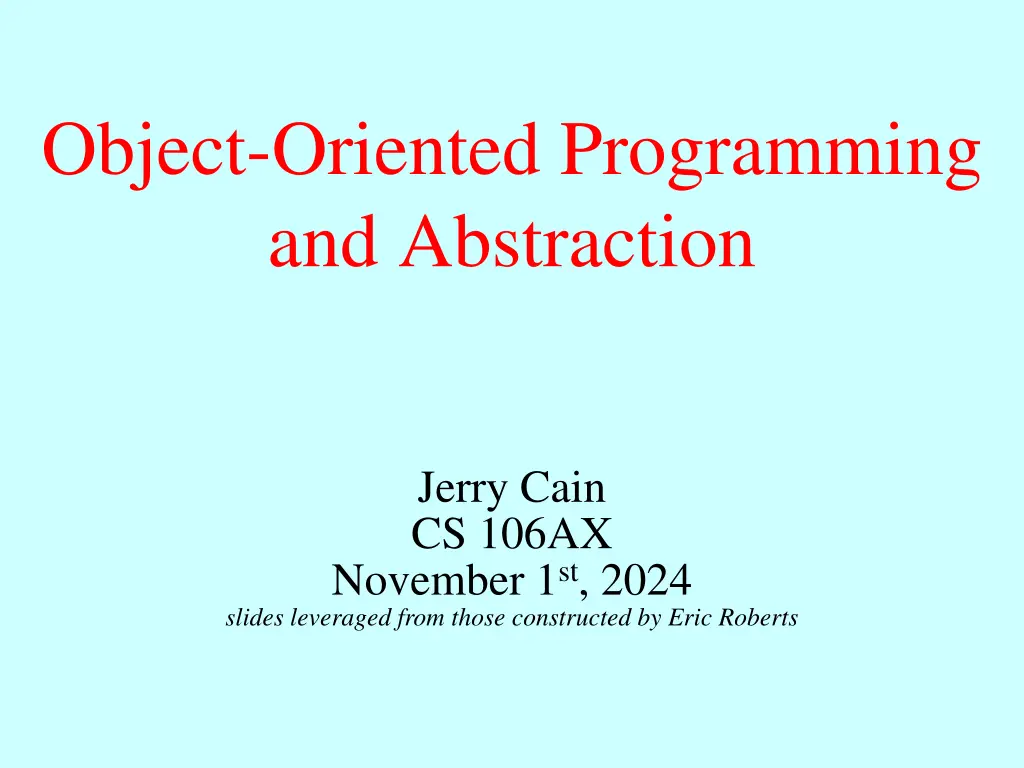
Understanding Object-Oriented Programming: Rational Numbers Implementation
Explore the concept of object-oriented programming and abstraction, focusing on encapsulation and inheritance principles in the context of defining rational numbers. Learn about the Rational class, encapsulation, and simulating rational calculations for exact computations. Dive into the fundamentals of OOP for precise fraction calculations.
Download Presentation

Please find below an Image/Link to download the presentation.
The content on the website is provided AS IS for your information and personal use only. It may not be sold, licensed, or shared on other websites without obtaining consent from the author. If you encounter any issues during the download, it is possible that the publisher has removed the file from their server.
You are allowed to download the files provided on this website for personal or commercial use, subject to the condition that they are used lawfully. All files are the property of their respective owners.
The content on the website is provided AS IS for your information and personal use only. It may not be sold, licensed, or shared on other websites without obtaining consent from the author.
E N D
Presentation Transcript
Object-Oriented Programming and Abstraction Jerry Cain CS 106AX November 1st, 2024 slides leveraged from those constructed by Eric Roberts
The Principles of OOP Object-oriented programming (often abbreviated to OOP) was invented in Norway in the 1960s but was not adopted widely for more than a decade. Object-orientation is defined by two principles, both of which I mentioned on Wednesday during my discussion of classes and objects in Python: Encapsulation The principle that data values and the methods that manipulate them should be integrated into a single coherent structure called an object. Inheritance The idea that objects and the classes that those objects represent form hierarchies that allow new classes to share behavior with classes at higher levels in the hierarchy. Today s lecture focuses on the use of encapsulation to define both the values and operations on rational numbers.
Rational Numbers Section 9.3 illustrates the idea of encapsulation by defining a class called Rational to represent rational numbers, which are simply the quotient of two integers. Rational numbers can be useful in cases in which you need exact calculation with fractions. Even if you use a double, the floating-point number 0.1 represented internally is actually an approximation. The rational number 1 / 10 is exact. Rational numbers support the standard arithmetic operations: Addition: Multiplication: a b c d ad +bc bd a b c d ac bd + = = x Subtraction: Division: a b c d ad bc bd a b c d ad bc .. = =
Implementing the Rational Class The next three slides show the initial version of the Rational class along with some brief annotations. As you read through the code, the following features are worth special attention: The constructor checks that rational numbers obey certain rules. These rules are described in more detail in the text but include reducing the fraction to lowest terms. For now, operations are specified using the receiver syntax. When you apply an operator to two Rational values, one of the operands is the receiver and the other is passed as an argument, as in r1.add(r2)
Simulating Rational Calculation The next slide works through all the steps in the calculation of a simple program that adds three rational numbers. 1 2 1 3 1 6 + + With rational arithmetic, the computation is exact. If you use floating-point arithmetic, the result looks like this: PyCharm >>> 1/2 + 1/3 + 1/6 0.999999999999999 >>>
Overloading the Arithmetic Operators The receiver syntax used in the RationalSum program makes the program hard to read, particularly for people unfamiliar with object-oriented programming. The program would be much clearer if you could replace a.add(b).add(c) with the more familiar expression a + b + c Unlike most modern languages, Python allows you to do just that. Each operator is associated with a special method name specifying how that operator should be implemented by the defining class. This technique is called operator overloading.
Redefining Addition As an example, you can define addition for the Rational class by providing a definition for the __add__ method. If you make use of the fact that the Rational class has an add method, the definition of the __add__ operator looks like this: def __add__(self, rhs): return self.add(rhs) Although this simple implementation works, it is better for clients if one can mix types in an expression. As long as the Rational operand appears to the left of the + operator, the __add__ method can define mixed-type addition by checking the type of rhs. If the Rational operand can appear on the right, you need to define the method __radd__ as well. The code for overloading + in both directions appears on the next slide.
Overloading Addition on Both Sides def __add__(self, rhs): if type(rhs) is int: return self.add(Rational(rhs)) elif type(rhs) is Rational: return self.add(rhs) else: return NotImplemented def __radd__(self, lhs): if type(lhs) is int: return Rational(lhs).add(self) elif type(lhs) is Rational: return lhs.add(self) else: return NotImplemented
Operator Methods in Python Redefines the + operator Redefines the - operator Redefines the * operator Redefines the / operator Redefines the // operator Redefines the % operator Redefines the ** operator Redefines the unary - operator __add__ __sub__ __mul__ __truediv__ __floordiv__ __mod__ __radd__ __rsub__ __rmul__ __rtruediv__ __rfloordiv__ __rmod__ __pow__ __neg__ __rpow__ (not applicable) Redefines the == operator Redefines the != operator Redefines the < operator Redefines the > operator Redefines the <= operator Redefines the >= operator __eq__ __ne__ __lt__ __gt__ __le__ __ge__ (symmetric) (symmetric) (inferred from >) (inferred from <) (inferred from >=) (inferred from <=)
Type Abstraction One of the most important advantages of the object-oriented paradigm is the idea of type abstraction, in which the goal is to think about types in terms of their high-level behavior rather than their low-level implementation. In computer science, types that are defined by their behavior are called abstract data types or ADTs. Python includes several built-in abstract types, and you have already seen a few implementations of abstract types, such as the Rational we just discussed last time. We ll spend the rest of lecture discussing strategies on how to define your own abstract data types.
Remembering Pig Latin One of the largest examples we covered while teaching JavaScript strings was a program that translated text from English to Pig Latin. We revisited that same program when we discussed Python s support for strings. Both Pig Latin translators decomposed the problem into two functions: a toPigLatin function that divides the input into words and a wordToPigLatin function that translates a single word to its Pig Latin equivalent. The first phase of this operation is completely independent of Pig Latin domain. It would be useful to have a package that divides input strings into individual units that have integrity as a unit, as words do in English. Since the same idea applies in contexts beyond human languages, computer scientists use the term token to define these units. A library that returns individual tokens from an input source is called a token scanner.
Designing a Token Scanner Section 12.2 in the Python reader describes a general library class called TokenScanner, which is implemented for several programming languages just as our graphics package is. The text also implements a small piece of that library that exports the following methods: scanner.setInput(str) Sets the input for this scanner to the specified string or input stream. scanner.hasMoreTokens() Returns true if more tokens exist, and false at the end of the token stream. scanner.nextToken() Returns the next token from the token stream, and "" at the end. scanner.ignoreWhitespace() Tells the scanner to ignore whitespace characters. These methods are the primary TokenScanner methods you need for your next assignment.

